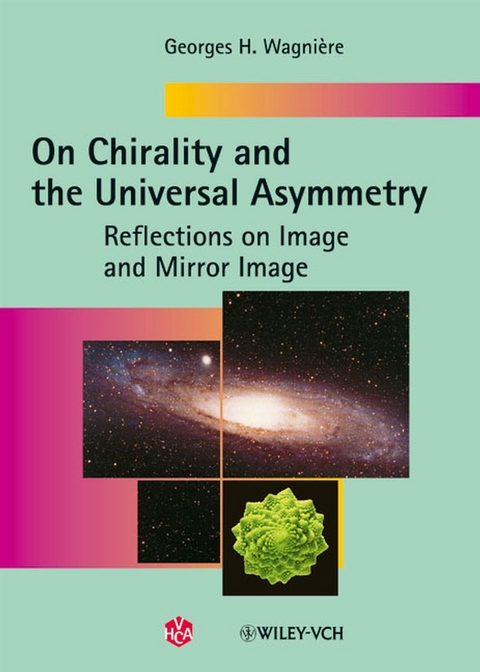
On Chirality and the Universal Asymmetry
Helvetica Chimica Acta (Verlag)
978-3-906390-38-3 (ISBN)
Georges H. Wagnière was born in Bern, Switzerland, in 1933. Following undergraduate studies at the Federal Institute of Technology in Zurich, he obtained a Ph.D. in Chemical Physics from Harvard University in the USA. After working for a few years in the chemical industry in Basel, he was appointed assistant professor at the University of Zurich in 1965, and promoted to associate professor in 1969. He became a full professor of physical chemistry in 1978. In the years 1990-92 he acted as dean of the Faculty of Science of the University of Zurich. From 1996-2000 he was president of the board of experts for the Swiss National Research Program on Nanosciences. He has been a visiting scientist at the IBM Research Center in San Jose, California, at the High Magnetic Field Laboratory in Grenoble, France, and an invited lecturer at the University of Lausanne. He retired officially from the University of Zurich in 1999, remaining scientifically active since. His research interests concern the electronic and optical properties of large molecules, focusing on natural optical activity, magneto-optics, magnetochirality, and nonlinear optics. Beside research papers in chemical and physical journals, ranging from Helvetica Chimica Acta to Physical Review A, he has published two books, Introduction to Elementary Molecular Orbital Theory and to Semiempirical Methods (1976), and Linear and Nonlinear Optical Properties of Molecules (1993).
Preface
Introduction
1. Image and Mirror Image in Molecules
1.1. The Homochirality of Life
1.2. The Discovery of Natural Optical Activity
1.3. Chirality and the Birth of Stereochemistry
1.4. Absolute Configuration
1.5. Asymmetric Synthesis
2. The Violation of Parity
2.1. Through the Looking Glass
2.2. Parity and the Laws of Physics
2.3. Time Reversal and the CPT Theorem
2.4. The Selectivity of the Weak Forces
2.5. Parity Violation in a Nuclear Reaction
2.6. Parity and Selection Rules in Atoms
2.7. The Violation of Parity in Atoms
2.8. The Violation of Parity in Molecules
2.9. The Interconversion of Enantiomers
2.10. From Meson Decay to Molecular Homochirality
3. Light, Magnetism and Chirality
3.1. Electromagnetism and Light
3.2. On the Interaction of Light with Molecules
3.3. Natural Optical Activity
3.4. Magnetic Optical Activity
3.5. The Magnetochiral Effect
3.6. The Magnetochiral Effect in an Atom
3.7. The Magnetochiral Effect in Molecular Fluids
3.8. Magnetochiral Photochemistry
4. The P, T- Triangle
4.1. Definition of Chirality
4.2. The Triangle of P- and T-Symmetry
4.3. The Inverse Magnetochiral Birefringence
4.4. The Magnetochiral Effect in Electric Conduction
4.5. Magnetochirodynamics
5. Journey into Outer Space
5.1. Remarks on the History of Science
5.2. The Evolution of the Universe
5.3. The Birth and Death of Stars
5.4. Is there a Temporal Evolution of the Basic Symmetries?
5.5. Galactic and Intergalactic Matter
5.6. Stellar and Galactic Magnetic Fields
5.7. The Fractal and Chiral Universe
6. Return to Earth
6.1. The Chaotic and Chiral Solar System
6.2. Asymmetry on Earth
6.3. Chaos in the Atmosphere
6.4. Geological and Mineralogical Chirality
7. Chirality at the Nano- and Micrometer Scale
7.1. On Chiral Crystals
7.2. Chirality in Liquid Crystals
7.3. Chiral Surfaces
7.4. Chiral Carbon Nanotubes
7.5. Observing Vortices
8. Chiral Models
8.1. The use of Models for the Description of Nature
8.2. Dissecting a Cube and a Sphere
8.3. From Dihedral Angles to the Classification of Knots
8.4. From Ligand Partitions to Chirality Functions
8.5. Sector Rules to interpret CD and ORD Spectra
8.6. From Helices to Möbius Strips
8.7. Coupled and Asymmetric Classical Harmonic Oscillators
8.8. An Early Quantum Mechanical Model
8.9. Are there Absolute Measures of Chirality?
8.10. On Multipole Expansions
8.11. Magnetochiral Scattering of Light
9. Pathways to Homochirality
9.1. Chiral Intermolecular Interactions
9.2. Enantioselectivity at Phase Boundaries
9.3. Enantioselective Adsorption on Chiral Surfaces
9.4. Chiral Chromatography
9.5. Enantioselectivity by Achiral Chromatography
9.6. Enantiomeric Excess by Chiral Catalysis
9.7. Homochiral Polymerization: Oligopeptides
9.8. Homochiral Polymerization: Polypeptides
9.9. Biopolymer Generation on Mineral Surfaces
9.10. Selectivity in Biopolymer Synthesis
9.11. Homochiral Organic Crystals
9.12. How Many Ways Lead to Rome?
10. Prebiotic Evolution and Beyond
10.1 What Is Life?
10.2. The Primary Origin of Absolute Enantiomeric Excess
10.3. Secondary Sources of Absolute Enantioselectivity
10.4. Prebiotic Evolution: from the Deep Sea to the Hadean Beach
10.5. Enantiomeric Excess by Surface Geology and Sunlight
10.6. Prebiotic Evolution: Extraterrestrial Origins
10.7. Prebiotic Evolution: Looking for Research Strategies
10.8. From Molecular Enantioselectivity to Biological Precision
10.9. From Molecular Enantioselectivity to Macroscopic Biological Chirality
"Die besondere Stärke des Buches ist seine didaktische Aufmachung."
Angewandte Chemie
2007-119/48
| Erscheint lt. Verlag | 6.6.2007 |
|---|---|
| Sprache | englisch |
| Maße | 170 x 244 mm |
| Gewicht | 660 g |
| Themenwelt | Naturwissenschaften ► Chemie ► Allgemeines / Lexika |
| Schlagworte | Biowissenschaften • Chemie • Chemistry • Chiralität • Life Sciences • Physics • Physik |
| ISBN-10 | 3-906390-38-1 / 3906390381 |
| ISBN-13 | 978-3-906390-38-3 / 9783906390383 |
| Zustand | Neuware |
| Haben Sie eine Frage zum Produkt? |
aus dem Bereich


